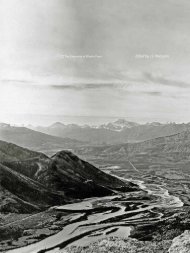C Ihe Ladies c cu. V'VVAN - History and Classics, Department of
C Ihe Ladies c cu. V'VVAN - History and Classics, Department of
C Ihe Ladies c cu. V'VVAN - History and Classics, Department of
- No tags were found...
You also want an ePaper? Increase the reach of your titles
YUMPU automatically turns print PDFs into web optimized ePapers that Google loves.
Notes to Pages 30-31 249no career interests until he emigrated to western Canada in1904. There he made a living packing for the railway, trapping,<strong>and</strong> working with surveyors <strong>and</strong> prospectors. In 1908, he joineda small trading party going north to the Great Bear Lake area,where he remained, trapping, hunting, <strong>and</strong> trading. Until hisreturn to Engl<strong>and</strong> at his father's death in the winter <strong>of</strong> 1925~26,he lived in <strong>and</strong> travelled throughout the Arctic, from theMackenzie River to Baker Lake, with time out only for the FirstWorld War <strong>and</strong> for a year guiding in the Rocky Mountains(1922-23). He lived by a combination <strong>of</strong> trading, trapping,prospecting, <strong>and</strong> hunting <strong>and</strong> fishing, with results that rangedfrom starvation to prosperity. In 1926, when he invited hiseighteen~year-old nephew Edgar Christian to return to Canadafrom Engl<strong>and</strong> with him, he had nearly two decades <strong>of</strong> experi~ence <strong>of</strong> northern life, but his way <strong>of</strong> life was one that made thebest <strong>of</strong> what came his way, not one guided by fo<strong>cu</strong>sed ambitionor forward planning. In Edmonton, Hornby <strong>and</strong> Christianwere joined by Harold Adlard, another young Englishman, <strong>and</strong>set out for the Thelon River, where they intended to build acabin <strong>and</strong> spend the winter trapping on the Barrens. However,the men missed the caribou migration. Poorly prOvisioned tosurvive the winter, all three died <strong>of</strong> starvation before the nextsummer. Edgar Christian, the last to die, left a diary <strong>of</strong> hisexperience which was recovered by RCMP <strong>of</strong>ficers Trundle,Williams, <strong>and</strong> Kirk, who reached the cabin on 5July 1929, after"eighteen months' persistent effort" (Steele 303). Initiallytitled Unflinching, Christian's diary went through several editions(Whalley in Christian, Death 5, 15-,14); it was most recentlyrepublished as Death in the Barren Ground. There have been twobiographies <strong>of</strong> Hornby (Waldron, Whalley).Fort Fitzgerald was a glooIllY place st<strong>and</strong>ing on slippery clayPhilip Godsell described it Similarly, as an "uninviting <strong>and</strong>squalid spot" (Arctic 187).we got a little roadster car to take us to Fort SIllith ... Ourdriver, half-Swede half-EskiIllo, had driven buffalo tea IllSover this portage as lately as 19IIIt is doubtful that buffalo were ever used on Smith Portage;from the time <strong>of</strong> the <strong>cu</strong>tting <strong>of</strong> the trail in 1882, the HBCfreighted with oxen <strong>and</strong> Red River carts (Mackinnon 24-5;photo in Cameron, rev. ed. 190). Because these couldcomplete ." about five full trips a week' ," it seems doubtful thatmany trips required four days to complete (King <strong>and</strong> Weekes164; qtd in Mackinnon 25). However, the ground was quicklyturned to quagmire by spring thaws <strong>and</strong> summer rains. The"partial shift to teams <strong>of</strong> horses <strong>and</strong> wagons" resulted from thedem<strong>and</strong> exerted suddenly in 1898 by the Klondike gold stampeders.The Ryan brothers introduced four-horse teams, <strong>and</strong>diminished these to two ~ horse units when road conditionsdeteriorated (Polyondi 68). In 1923, the American furcompany Lamson <strong>and</strong> Hubbard brought Linn caterpillar tractorsinto service on the portage (Mackinnon 25, 29). The firstautomobiles were used in 1921 (On the Banks 78).Somewhat surprising in connection with buffalo is Vyvyan'ssilence over the ongoing project at Wood Buffalo NationalPark. Beginning in the previous year <strong>and</strong> continuing until1928, a total <strong>of</strong>6,673 plains bison were shipped by rail <strong>and</strong>sternwheeler north to the park from Wainwright, Alberta tojoin the 1,500 wood bison already in the park (Kitto, North West85, 86). Sherwood Platt recorded "250 live wild buffalo" onthe train he took to Waterways on 6July 1926 (6), so Vyvyan<strong>and</strong> Dorrien Smith must have been unlucky in the timing <strong>of</strong>their trip. This project was overseen by ColonelJames K."Peace River Jim" Cornwall, who was <strong>of</strong> the view, novel for thetimes, that '''the commercial prosperity <strong>of</strong> the country is in theh<strong>and</strong>s <strong>of</strong> the Indians''' (Fumoleau 235). His name appears inChpt 2 <strong>of</strong>Vyvyan's book, in Romanet's letter.The confusion over buffalo being used on the portagemight have been deliberate or accidental. The women's driver,identified as McNeil in Vyvyan's field note for 7 June, wasWilliam Georges Andes "Billy" McNeill (1891-1978), fromLabrador, who went north in 19II to help the federal govern~ment conduct its failed experiment with the grazing <strong>of</strong>reindeer. Later, he was appointed as the first park warden forWood Buffalo National Park (Swanson). In the opinion <strong>of</strong>Kenneth Conibear, he was pulling no one's leg when he said hehad driven teams over the Smith portage as late as 19II, "r thinkhe meant reindeer, not buffalo, but the women knew that hewas now a buffalo ranger <strong>and</strong> thought he meant buffalo. Andpossibly he was jesting. He had a great sense <strong>of</strong> humour, <strong>and</strong>was a delight to have around" (Conibear). OfIrish <strong>and</strong>possibly Metis descent, McNeill certainly was not mixed bloodSwedish <strong>and</strong> Inuit. He operated W.G.A. McNeill Taxi out <strong>of</strong>Fort Smith from the mid-1920s to 1950. In 1916, he marriedMarie Celestine Squirrel (1904~24), daughter <strong>of</strong> chief PierreSquirrel <strong>and</strong> Marguerite M<strong>and</strong>eville; in December 1924, hemarried EleonoreJeremie (Swanson).
















